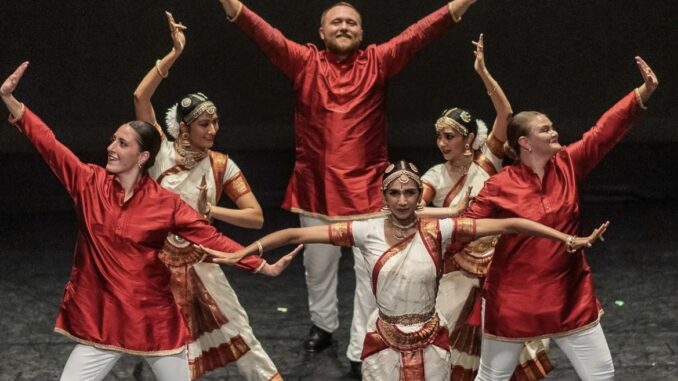
By Kate Dempsey
Brilliant colors filled the stage, the adornments of gold on the Indian dancers creating a kaleidoscope of beauty. Audience members leaned in, mesmerized by the stage as they were transported to India. At the same time, the audience was transported to mid-century America as tap dancers joined the stage, entering a new realm of existence where these two periods meet.
The Erasing Borders Dance Festival returned to New York City from Sept. 23 to 24 at the Ailey Citigroup Theater, organized by the Indo-American Arts Council (IAAC). IAAC is a non-profit arts organization whose goal is “promoting, showcasing and building an awareness of the arts and artists whose heritage lies in the India in the performing arts, visual arts, literary arts and folk arts.”
The festival has been held every year since 2008, with this year marking its 15th anniversary. According to organizers, the festival was created to bridge the gap between what the American public understood about Indian dance, and joining it with contemporary styles that they were more familiar with.
“We felt at that time that not enough people understood the diversity that is in Indian dance and that they had a very sort of orientalized vision of it, a very stereotyped image of it, and we wanted to break that and bring dance into something fresh and contemporary,” said Uttara Coorlawala, head organizer and co-founder of the festival.
For choreographers of the show, the goal of the performance was to combine traditional Indian dance, such as the classical Bharatanatyam dance form that emphasizes foot work and emotional expressions based on face and hand gestures, with contemporary styles of American dance.
“The goal was to take a Margam, which is like a traditional Bharatanatyam evening show, and condense that into 25 minutes and see what would happen when you added tap dancers to it,” said Vikas Arun, one of the show’s choreographers.
A Margam typically starts with an offering and prayer, and uses chants to convey peace and religious practices. Organizers combined this with tap dance, a dance style originating from the West African tradition that relies on shoes striking the floor to create rhythm. The challenge with combining these types of dances is the use of polyrhythm in Indian music, which is not present in Western styles of dance and can make it difficult to coordinate.
At a panel discussion held on Sept. 25, choreographers and dancers discussed their processes for putting the show together, as well as sharing more about their backgrounds. The dancers offered advice to the audience on supporting oneself as a dancer, sharing their stories and the journey it took them to get to where they are now. For dancers attending the panel, it expanded their knowledge about the different movements happening in the dance world.
“I do different Indian classical dance than like the panelists here today,” said Malavika Singh, a para-professional dancer and student at Columbia University. “I definitely want to learn more about the more modern explorations that are happening in the contemporary dance world, seeing how people are bridging these very traditional forms into a modern purpose.”
The panelists also discussed many of the additional hurdles that Indian dancers face when rehearsing or putting on a show compared to dance forms that are Eurocentric in tradition. Oftentimes, equipment such as microphones or proper wood floor paneling would not be provided for traditional Indian dance companies, whereas dance companies with Eurocentric styles of dance were easily granted proper equipment.
“It’s a little frustrating that there are these additional hurdles for forms that are not under that Eurocentric umbrella,” said Dipashreya Sur, co-organizer of the festival. “You really have to jump through some hoops to find a solution, and often, it’s not necessarily the most optimum solution but it’s just a solution that will do.”
To break the barriers between what is made available to Eurocentric styles of dance and those of the Indian tradition, organizers continue to advocate for their own equipment even through the dominance of the Eurocentric dance sphere.
“In my career, I did experience a lot of Eurocentricity in the way that stage is and, for example, the inability to get back speakers at the back of the stage for our show […] We have to sort of work with the current dominant practices and somehow come through with our own sensitivities and aesthetic ideas,” Coorlawala said.
Despite these challenges, Coorlawala seeing how much the audience loved the show afterwards made it all worth it. Recognizing the immense diversity of the audience members who come to see the show proves that the festival is indeed erasing borders.
“Another favorite part is the moment backstage when people are just dreading to go on, and all the performers are there waiting for their turn and everyone is quiet and everyone is just focusing. One person is warming up, one person is just standing there, another is pacing up and down,” Coorlawala said. “But it’s a community, it’s a communal performance.”
